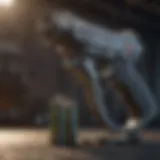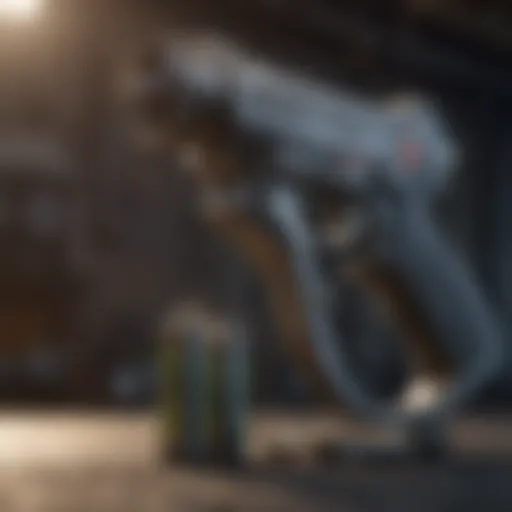Invisible Dog Fences for Acreage: A Complete Guide
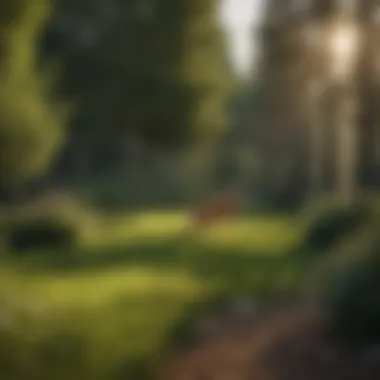

Intro
Invisible dog fences are becoming increasingly popular, especially among homeowners with larger properties. These systems offer a practical solution to keep dogs within designated boundaries without compromising the aesthetics of the landscape. Compared to traditional physical fences, which can be visually obstructive and require considerable maintenance, invisible dog fences provide a discrete, effective method for pet containment.
It is essential for dog owners to understand not just the functionality of these fences, but also their importance. Dogs, by nature, need room to roam and explore; however, owners also worry about their pets wandering off, encountering traffic, or getting lost. An invisible fence allows dogs the freedom they desire within a controlled area while providing peace of mind to their owners. This guide will explore the various aspects of invisible dog fences tailored specifically for larger properties.
Importance of the Topic
As the number of homeowners with vast outdoor spaces grows, understanding how to effectively contain pets within these boundaries becomes crucial. The topic of invisible dog fences encompasses various elements, including technological advancements, installation processes, and best practices. Homeowners must make informed decisions that prioritize the safety and well-being of their pets, while considering personal preferences and budget constraints.
In summary, this article aims to break down the complexities of invisible dog fences for acreage. By providing clear insights, practical solutions, and comprehensive recommendations, it empowers homeowners, especially those managing larger properties, to implement optimal pet-containment strategies. This understanding not only enhances pet safety but also reinforces a tranquil and secure living environment suitable for both owners and their pets.
"An informed choice leads to a better living experience for both pets and homeowners."
Understanding Invisible Dog Fences
Invisible dog fences represent an evolving solution for pet owners, particularly those with larger properties. Satisfying the needs of both pet and owner entails an understanding of how these systems function. This section aims to detail essential components of invisible dog fences, offering a foundation for informed decisions in managing your dog's freedom within a spacious yard.
Definition and Mechanics
Invisible dog fences consist of a transmitter and a receiver collar. The transmitter is generally placed within the home or in a central area of the outdoor space. It emits a consistent radio signal, forming a boundary defining the territory where the dog can roam freely. When the dog approaches the boundary, the receiver collar emits a warning beep, followed by a mild static correction if the dog crosses this limit. This safe and humane method is designed to reinforce the awareness of boundaries without physical barriers.
Types of Invisible Dog Fences
Invisible dog fences can be categorized essentially into three types, each with distinct advantages.
Wired Systems
Wired systems connect an underground loop of wire buried along the desired boundary line. The key characteristic of wired systems is their stability and reliability in large acreage conditions. Being tethered to a physical wire ensures minimal interference, making this option a beneficial choice for ensuring thorough coverage. The advantages include a broad operating range and flexibility in programming boundaries, but installation may require significant effort and expertise.
Wireless Systems
Wireless systems, on the other hand, utilize transmitter towers that broadcast signals within a circular range. The ease of installation is a crucial aspect, as no digging is necessary. They are a popular choice for property owners who prefer simpler setups without the need for extensive planning. However, the limitations include a potentially reduced range when placed in more uneven terrain. These systems may also be influenced by environmental factors, leading to variations in effectiveness in complex layouts.
Rechargeable vs.
Non-rechargeable Collars
Rechargeable collars offer convenience for daily use, requiring less frequent battery replacements. This feature ensures that the collar’s battery is always ready for operation, contributing to better reliability. Non-rechargeable collars require manual changes, which can become cumbersome over time, especially if physical access to the collar eight ⠀an issue. Each has its pros and cons, yet rechargeable options provide long-term cost effectiveness by reducing the frequency of replacements.
Conclusion: Understanding various types of invisible dog fences and their mechanisms is fundamental in making measured decisions that regard practicality for pet management on larger properties.
Benefits of Using Invisible Dog Fences on Larger Properties
Using invisible dog fences on larger properties can transform how pet owners manage their animals. Unlike traditional fencing, invisible options have their own unique advantages. This section explores the benefits in detail to guide homeowners as they consider the best ways to secure their pets within expansive spaces.
Flexibility in Boundaries
Invisible dog fences offer remarkable flexibility. Property owners can easily adjust the layout of the boundaries to correspond with the changing needs of their surroundings.
Whether you have rolling hills, dense woodlands, or open fields, invisible fences can adapt. This flexibility can prove crucial in maximizing the land's usability. During summer or winter, adjustments to the boundaries may optimize your pet’s roaming area while keeping them safe. Pet owners can include specific areas off-limits for safety, like gardens or hazardous zones. Thus, this characteristic of versatility makes invisible dog fences a logical choice for larger homes where traditional fencing may be infeasible or restrictive.
Cost-Effectiveness Compared to Traditional Fencing
Cost is an essential factor when setting up systems to secure pets. Invisible dog fences generally present a more economically feasible alternative to traditional outdoor fencing.
Initial cost for wired or wireless systems does not usually meet the expenses for labor intensive wooden or metal fences. Further costs for maintenance may also result in more spending for traditional options around yearly repairs or repainting. Only basic maintenance is needed for invisible fences, saving further hassle. Moreover, long-term considerations must include the value of utilizing open spaces effectively, where traditional barriers may restrict pet freedom. This makes an investment in an invisible dog fence financially sound for many property owners.
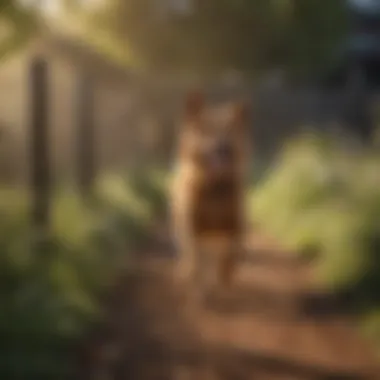

Preservation of Landscape
Larger properties often feature picturesque landscapes that bear significant aesthetic value. Traditional fencing struggles to blend seamlessly into these environments, often dwarfing and obscuring natural beauty. Conversely, invisible fences maintain the property's merged nature and integrity.
With reversible installations, these invisible systems protect not just pets but also the visual appeal of the property. Unobtrusive methods help tend dog safety without interrupting landscaping efforts. Physical barriers get in the way of enjoying undisturbed views, while invisible options leave your space looking undisturbed and spacious, thus preserving that pristine landscape pet owners greatly desire.
Invisible dog fences promote both choice and convenience while respecting your property’s layout, ultimately providing better lifestyles for pets and owners alike.
Limitations and Challenges of Invisible Dog Fences
Invisible dog fences offer convenience, but they are not without drawbacks. Understanding their limitations and challenges is important for residents managing larger properties. Knowledge of these challenges helps ensure that both homeowners and pets are prepared for any potential issues. Awareness fosters informed decisions, minimizes risks, and promotes pet safety in wide-open space.
Terrain Considerations
The landscape and terrain of the property can significantly impact how invisible dog fences function. Uneven ground, hills, and dense vegetation may lead to inconsistent signal transmission, and this can confuse pets. Electrical signals can struggle to penetrate obstacles in the environment, which is particularly relevant for larger properties.
Homeowners should assess their land carefully. Areas with substantial elevation may restrict the effective radius of the transmitted signal. Likewise, thick shrubbery can create blind spots that might allow pets to escape undetected. Thus, owners must prepare to regularly review and adjust the layout of their wireless settings, or they might note gaps during regular checks.
Weather Influence on Performance
Weather conditions can also affect the operation of invisible dog fences. Extreme temperatures, heavy rains, and other weather scenarios may disrupt the effectiveness of the system. Air moisture can alter signal behaviors and affect the reception within certain areas of the yard.
For wet weather, a permanent moist environment can cause malfunction in both the collar and the shock mechanism, especially with non-rechargeable systems. Likewise, severe cold can deplete batteries faster than normal, giving a false sense of security occasionally. Assessing weather vulnerabilities and the warranties of products during different seasons is an aspect of care homeowners must carry out.
Pet Training and Adaptation Period
Training pets is a continual process when introducing them to invisible dog fences. The adaptation period can vary widely among animals. Some may simply take to the fence quickly, while others require more time and effort to become acclimated.
It is prudent for owners to engage in systematic training routines. Gradual exposure helps prevent anxiety and promotes comfort with the invisible boundaries. Using treats and positive reinforcement will cultivate a better relationship between pet and system.
Consistent monitoring will help owners gauge their pets' responses. Some dogs may instinctively challenge the boundaries, and solutions must be put in place to correct this behavior early on. Transition takes then both thoughtful effort and patience, highlighting the necessity of commitment for optimal results.
Installation Process for Acreage
The installation process is a critical aspect when it comes to invisible dog fences on larger properties. The precision and planning involved not only ensure the effectiveness of the system but also directly affect your pet’s safety and your peace of mind. Using an effective invisible fencing system helps create designated boundaries without imposing on the aesthetics of your yard. Each step in this process is integral, from planning and understanding your property to the tools required for installation.
Planning and Measurement
Careful planning and accurate measurement serve as the foundation of a successful installation. Begin by surveying your property to want the boundaries. This ensures that your dog's activity stays within a controlled area without restrictions imposed by physical fencing. Identify points that may pose risks, like a busy road or steep drops. After determining the layout, create a rough sketch, marking where fence lines will go.
Use measuring tools to outline the distance carefully. Get the measurement of the total area intended for coverage. It's vital; uneven grounds, obstacles, and any existing structures should also be taken into account during this phase. A thorough plan reduces complications and provides clarity, leading to more efficient installation down the line.
Tools and Equipment Needed
Gathering the right tools is essential before diving into installation. Below is a list of tools that will simplify the process: Boundary flags: Useful for marking outlines before the wire installation. Wire: Specifically designed for underground fencing, ensure to purchase sufficient length based on measurements taken earlier. Splicer and connectors: In case of breaks in the system, these are important for maintenance. Trowel or shovel: Needed to bury the wire along the boundary lines efficiently. Screwdriver: This tool helps when fixing the transmitter to a permanent location. Collar charger: Having a charger for the collar ensures it's always ready for use.
Having the right tools at hand streamlines the installation process and reduces delays.
Step-by-Step Installation Procedure
Properly sticking to an organized procedure can make or break an installation. Below is a step-by-step guide:
- Outline Your Boundaries: Use boundary flags to visually layout the area before committing. Ensure it meets your property’s unique shape and includes any barriers or openings.
- Install the Wire: Dig a shallow trench along your marked boundary lines and place the wire inside. Ensure to bury it deep enough to avoid potential damage while still being accessible for young pets.
- Set Up the Transmitter: Place your transmitter indoors, near a suitable power outlet. It should also have easy access to the perimeter wire for connecting.
- Connect the Wire to the Transmitter: Follow manufacturer instructions for connecting. Make sure there is a solid contact between both components.
- Test the System: Before finalizing, conduct a test to and identify any weaknesses or potential issues. Doing this now allows you to fix any problems before introducing your pets.
- Finalize the Installation: Once testing is complete, tidy up the installation area. Remove any extra tools, and set up the training area for your dog. All set ? you now have installed invisible fencing on your site.
Safety Note: Always read instruction manuals thoroughly to avoid mistakes, ensure effectiveness, and keep pets secure.
By following these steps, the installation of an invisible dog fence becomes much more manageable. The added protection and freedom it offers to dogs in motion across the acreage are significant benefits that make this effort worthwhile.
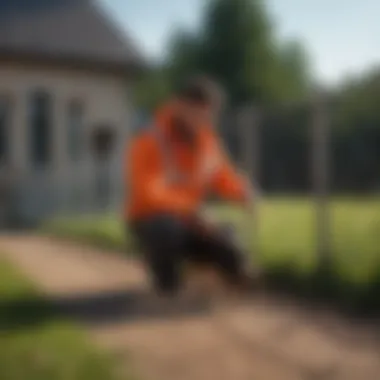

Selecting the Right System for Your Acreage
Selecting the right invisible dog fence system is critical to ensuring both the safety of pets and the integrity of your property. The best system integrates seamlessly with your yard's natural features while addressing the specifics of your dog's behavior. This section breaks down essential considerations that help you make an informed decision regarding the appropriate invisible fence.
Assessing Your Property's Size and Layout
The size and layout of your property fundamentally dictate the suitability of various invisible fencing systems. Larger grounds often necessitate different systems than smaller ones, predominantly due to the additional factors like terrain and layout concerns.
When assessing your property, start by taking accurate measurements. Map out shapes, dimensions and locations of plants or other obstacles as these can affect signal strength. For properties over an acre, a wired system might offer greater reliability compared to a wireless system. Here are several key points to consider:
- Zoning: Larger properties may have complex layouts. By zoning the areas where your dog needs freedom, you can discover how much wire is required or how far a wireless transmitter must reach.
- Obstacles: Trees, buildings or even changes in elevation can affect the efficiency of invisible fences. Ensure the system you choose accounts for these elements.
- Security Needs: Assess where you want your pet to roam. A more controlled fence might be suitable around the house and garden areas, while other spaces can provide more freedom.
Understanding Your Dog's Behavior
Understanding your dog's behavior is crucial to selecting the best invisible fence system. Different systems and training protocols influence how a dog reacts once it learns the boundaries.
Take note of those characteristics:
- Temperament: Is your dog timid or bold? A strong dog may require a higher correction level while a sensitive dog might do well with lesser signals.
- Training History: Evaluate how much previous training and exposure your dog has had with collars. This impact your choice on collar types—some dogs adjust well to electric collars while others struggle.
- Escape Tendency: Dogs prone to roaming need systems that quickly transmit corrective signals to prevent them from wandering too far. An evaluation of past behavior can identify your dog's impulsivity.
Comparing Brands and Models
Every invisible dog fence system is advertised as solution for pet owners, yet it's critical to compare brands and models rigorously. Factors like reliability, price, features, and reviews must influence your decision, as each has its advantages and potential drawbacks.
When reviewing brands, consider the following aspects:
- Warranty and Support: Reliable companies often back their products with decent warranties and effective customer support systems.
- Adjustability: Collars should provide varying levels of corrections. Choose models that allow customization based on your pet's distinct needs.
- Installation Complexity: Some systems are easier to install than others, which can affect your overall satisfaction and practicality after purchase.
- User Reviews: Research feedback online from users on platforms like Reddit to gather impressions.
Evaluating these aspects ensures you choose a system that meets both your property needs and safety measures for your furry family member, finally bringing the peace of mind required for pet ownership.
“Securing your pets is not just about preventing them from running. It is about providing them freedom within a safe environmment.”
Best Practices for Introducing Dogs to Invisible Fences
Introducing dogs to invisible fences can be a significant transition. It is essential to follow specific methods to ensure that pets fully adapt to their new boundaries while feeling safe and secure. Doing so can prevent potential problems down the line, such as behavioral issues or anxiety linked to confusing situations. Proper preparations, monitoring, and support can greatly enhance the overall experience of using an invisible fence.
Gradual introduction techniques
One widely recommended method for introducing your dog to invisible fences is the gradual approach. This technique involves three key stages:
- Initial Exposure without Simulation: Begin by allowing your dog to roam in the fenced area without the collar or any stimuli. This can help your dog familiarize themselves with the exclusive boundaries, and the general layout of the area helps without any distractions. You should also walk with them in this space and engage in their favorite activities.
- Subtle Introduction of Boundaries: After your dog appears to be acquainted with the area, put the collar on them but avoid activating the shock feature initially. Let them become accustomed to wearing it. Accompany your dog during this phase, rewarding them with treats every time they get close to the boundary. This positive reinforcement builds trust in the process.
- Gradual Stimulation: Once your dog is comfortable and familiar with the collar, you can begin testing the limits. You can do this gently by letting them approach their boundaries, allowing the collar’s warning signal to activate at first before introducing stronger corrective measures. Always keep a grounded method of assurance handy, as a relaxing voice can accompany corrections. Gradual exposure allows your pet to learn without the fear of needing to switch boundaries constantly or getting successive corrections to get out.
Utilizing SLOW and gentle steps to bring your dog into their new reality is essential. Progressing through these phases will help minimize any confusion or fear your dog may feel.
Monitoring Dog Behavior
Monitoring your dog during the initial training is essential. Potential signs of confusion, anxiety, or fear should not be overlooked. Signs may include:
- Whining or barking near the boundary line.
- Hesitation when approaching the boundary.
- Displaying nervous behaviors like tail tucking or rapid panting.
To effectively monitor behavior, consider these practical approaches:
- Observation: Spend time watching how your dog reacts when they reach the defined border. Observing body language will provide essential clues about their comfort level.
- Progress Tracking: Jeraate a chart noting your dog’s reactions over time, ensuring consistency in identifying progress. Keeping track helps tweak your training method if the dog appears stressed or uncomfortable.
- Involvement of Family: Get family members involved by allowing them to observe sessions. Having multiple viewpoints ensures more comprehensive monitoring of their behavior.
Gradually allowing your dog to feel and learn without undue pressure will enhance the adaptation journey. Recognizing their moods enables you to take necessary actions and adjust your techniques shortly while boosting their confidence as time progresses. Importantly, communication and patience are vital. Allow the process to unfold naturally, reassessing at every critical point.
Properly introducing and training your dog helps in turning negative responses into positive experiences with invisible fences. Always support and guide your furry companion, fostering trust and confidence.
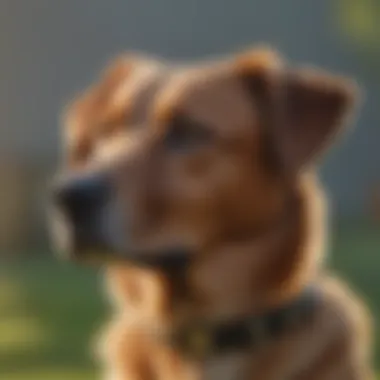

Ongoing Maintenance and Troubleshooting
Maintaining an invisible dog fence involves ongoing attention and quick troubleshooting. This is important for ensuring reliability in the long run. Even if the initial installation is successful, the system’s performance can decline without proper maintenance. Regular attention minimizes the risk of escape and protects your dogs’ safety. It can also prolong the life of the system, resulting in better investment over time. Furthermore, understanding common issues helps you address them promptly, reducing potential losses. Overall, proactive measures create a worry-free environment for both pets and their owners.
Regular System Check-Ups
Regular check-ups are essential for verifying the system's efficiency. At least once a month, inspect critical components both inside and outside. Ensure the transmitters are secure, and visual checks on borders for any interferences can make a difference. Pay attention to battery life in collars and f their function. Keeping the system in pristine condition prevents problems arising. Make these check-ups a part of your routine, similar to household chores, to enjoy an operational fence.
Common Issues and Solutions
Signal Loss
Signal loss refers to when the transmission between the fence and the dog's collar becomes unstable or completely disrupts. Factors like building materials or interference from electronic devices can cause signal loss. Homes with metal siding or older wiring may encounter this issue more frequently. To mitigate it, consider relocating transmitters or making adjustments when installing. It's crucial to understand that signal loss often leads to confusion for a pet and could cause untrained behaviors. Maintain the signals for optimal performance.
Collar Malfunctions
Collar malfunctions cover a range of problems, from dead batteries to poor fit. This can cause the collar to malfunction during improper movement or training. One of the reasons malfunctioning collars can be detrimental is safety; it might not alert your dog with the appropriate warning if faulty. Frequent inspections should include checking the battery life and fit on the dog's neck. Avoid physical damage due to rough play because collar durability varies.
IMPORTANT: Frequent monitoring of both the system and the collar enables successful management of your invisible fence. In case solutions for signal loss or collar malfunctions fail, consult your system's user manual for fresh methods or contact customer support.
Regular maintenance helps to limit problem occurrences. When you trouble-shoot efficiently, you develop a better environment not only for your dogs but also for your peace of mind.
Long-Term Considerations
Understanding the long-term considerations of invisible dog fences is essential for ensuring their effectiveness and for the safety of your pets. As your property and your dog's needs evolve over the years, it becomes crucial to regularly evaluate how the invisible fence performs and how well it meets your current requirements. This section will explore two vital aspects: reassessing boundaries and recognizing the changing needs of your pets.
Reassessing Boundaries Over Time
Once you have installed an invisible dog fence, the initial boundaries are based on your property layout and your dog's behavior at that time. However, as the seasons change, new growth occurs, or even changes in property usage can affect these boundaries. For instance, if you add new gardens, structures, or pathways, you might need to revise the containment zone.
Regularly reassessing the boundaries can help you avoid potential mishaps. Pets can occasionally discover ways to break through if the fence area is not aligned with current acceptable zones. Incorporating ultrasonic point locations where a dog can approach freely but not enter restricted areas might also improve performance.
In addition, be attentive to changes in landscape. Areas that once were free of obstacles might suddenly become more challenging due to foliage growth or weather changes. Ensuring that these adjustments are made continuously will improve overall safety.
Evolving Needs of Your Pets
Pets are not static; their needs, behaviors, and perhaps size, can change. A dog's physical capacity to explore and how you choose to interact with your pet might require altering the established protocols around your dog fence. For instance, a growing puppy develops different energy levels and spatial needs when it becomes an adult. You might discover that the original boundaries no longer suit their quarterback energy style.
Also, behavioral factors, such as leash training or playtime preferences, might lead to adjusting their freedom zones. Some dogs may need incentives that motivate them to stay within safely defined areas rather than searching beyond the perimeter. Take some time after your dog's bi-annual vet visit to consider how they adapt their fitness to age; senior pets may no longer need the same confining areas.
It's important that the upkeep of boundary settings aligns well with your dog's personal growth and behavioral shifts. Ensuring the perfect fit means keeping a flexible and observant approach.
Regular monitoring and adjustments based on changing needs will enhance both safety and the happiness of your pets.
Legal and Regulatory Aspects
Understanding the legal framework around invisible dog fences is essential for several reasons. This segment angulates where liability and responsibility lie in the usage of such systems. Moreover, it accentuates compliance with relevant local laws and regulations— factors that directly influence the effectiveness and validity of using an invisible dog fence for pet control.
Any system installed without proper consideration for legal requirements could lead to unnecessary complications. This can involve fines, order to dismantle the system, or even disputes with neighbors. Being informed about these regulations can save potential headaches down the line while ensuring that your dog's safety remains the focus.
Local Laws and Regulations
Laws around pet containment can differ significantly from one area to another. Local statutes may define what type of fencing or containment is acceptable, where it can be placed, and at what dimensions. It's crucial to consult local ordinances before installation. In many counties, invisible dog fences are allowed, provided restrictions on maximum boundary lines are adhered to.
Moreover, zoning regulations may require that whichever containment method employed meets specific safety standards. Some residential areas may instill special rules regarding electric fences, which means obtaining a permit before setting up your system. Consulting your municipality’s regulations offers clarity and can prevent penalties.
Liability and Insurance Considerations
Liability for incidents involving pets often rests with the pet owner. Insurance coverage can be nuanced when it comes to invisible dog fences. Not all policies cover issues stemming from the use of these systems, especially if the pets escape and cause havoc.
It's prudent to review your homeowner’s policy closely. Ask if it explicitly covers liabilities connected to accidents involving pets that have escaped an invisible dog fence. Additionally, you might want to conduct a risk assessment of your property. To safeguard against potential claims, consider additional coverage. Obtain quotes for policies that cover possible mishaps associated with invisible dog fences. Your thoroughness in these matters can often spare considerable trouble and costs in the long run.
"Review your insurance policy to ensure coverage includes all liability relating to pet accidents, inclusive of incidents arising from the use of invisible dog fences."


